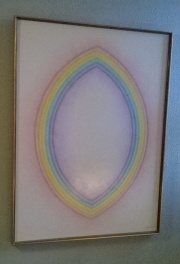Mandorla No. 12 (art work): Difference between revisions
No edit summary |
No edit summary |
||
| (3 intermediate revisions by the same user not shown) | |||
| Line 1: | Line 1: | ||
[[File: | [[File:Mandorla -12.jpg|right|180px|thumb|''Mandorla #12'' at Theosophical Society in America]] | ||
{{DISPLAYTITLE:''Mandorla No. 12'' (art work)}} | |||
'''''Mandorla #12''''' is painting created by [[Burton Callicott]], a member of the Memphis Lodge of the [[Theosophical Society in America]]. It was donated to the Society by his daughter in 2008 for the collection in the [[L. W. Rogers Building]]. Callicott painted this work in 1989, using oil paints on linen. The technique involved preparing the canvas with thick layers of underpainting to obscure the texture of the cloth. Many layers of color-pigmented translucent glazes were applied, and each band was blended with a stipple brush. | |||
The dimensions of the painting are 44 x 59 inches, or 119 x 150 cm. Callicott also created a smaller [[Mandorla (art work)|'''''Mandorla''''']] in pastel. | |||
The '''[[Mandorla|mandorla]]''' is a symbol in many cultures and religions, and the name derives from the Italian word for almond. | |||
The | |||
[[Category:Art works]] | [[Category:Art works]] | ||
Latest revision as of 19:33, 23 September 2021
Mandorla #12 is painting created by Burton Callicott, a member of the Memphis Lodge of the Theosophical Society in America. It was donated to the Society by his daughter in 2008 for the collection in the L. W. Rogers Building. Callicott painted this work in 1989, using oil paints on linen. The technique involved preparing the canvas with thick layers of underpainting to obscure the texture of the cloth. Many layers of color-pigmented translucent glazes were applied, and each band was blended with a stipple brush.
The dimensions of the painting are 44 x 59 inches, or 119 x 150 cm. Callicott also created a smaller Mandorla in pastel.
The mandorla is a symbol in many cultures and religions, and the name derives from the Italian word for almond.
